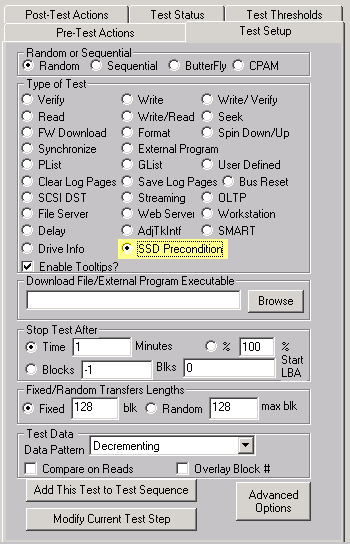In the next release of STB Suite, the Disk Manufacturing Module (DMM) will contain a new test – the “SSD Preconditioning” test. A picture below shows the new test in the array of test choices:

To “precondition SSS or a SSD” is a fairly complex process, a process whose goal is to determine if the drive is in a stable state. This process involves writing the SSD drive twice, and then taking performance measurements, and then mathematically analyzing these measurements to determine if the drive is in a stable state. The new SSD Preconditioning Test incorporates all of this mathematical analysis, alleviating the user from having to digest all the complex criteria for this preconditioning process.
After the SSD Preconditioning Test has completed, the log file will contain a summary of all the technical details for how we determined the drive is in a stable state. Here is a sample log file output:
------------------------------------------------------------------------------ 10/11/2012 08:17:10 TEST 2 of 2: SSD Precondition (Performance) Test Stop-on-Error Type: Stop Current Test
Measurement Window Values: 228.90 MB/s, 240.21 MB/s, 240.60 MB/s, 240.71 MB/s, 240.71 MB/s
The above 5 values forms a "Measurement Window" because of the following information
Average of Measurement Window Values: 238.23, Maximum Difference of Measurement Window Values:11.82
Max Difference of Values is 5.0% of Average Values, which is <= 20%
Least Squares Slope: 2.41, Least Squares Y-Intercept: 238.23, Maximum Difference on Least Squares Line:9.66
Max Diff of Least Square Line Values is 4.1% of Average Values, which is <= 10%
Total number of Measurements Taken: 10
10/11/2012 09:26:40 Test Completed Successfully
10/11/2012 09:26:40 PASSED ------------------------------------------------------------------------------
Here we explain some of the technical details in the log file. After writing the drive twice with a workload which is independent of the measurement values, we run a 1 minute test and get the transfer rate for this 1 minute interval. We then buildup 5 measurement values, each value being the transfer rate from a 1 minute interval. We then “feed” these 5 values into our mathematical cruncher to determine if the drive has a stable transfer rate. If it does NOT, we then continue with another interval. As you can see from the log file, we had to take 10 measurement values. The final 5 values are printed in the log file (these are the values 228.90 MB/s, 240.21 MB/s, 240.60 MB/s, 240.71 MB/s, and 240.71 MB/s). Our mathematical cruncher determined two criteria were satisfied:
- That the maximum difference of the measurement values was less than 20% of the average of the 5 measurement values (in fact, the log file indicates the maximum difference was only 5.0% of the average).
- If you take the Method of Least Squares line going through these 5 measurement values, the maximum difference on this line must be less than 10% of the average of the measurement values (in fact, the log file indicates the maximum difference on the least squares line was only 4.1% of the average).
That criteria #1 and #2 were satisfied, the drive is considered preconditioned (i.e. is in a stable state in relationship to performance).